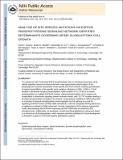| dc.contributor.author | Huang, Paul H. | |
| dc.contributor.author | Miraldi, Emily Rae | |
| dc.contributor.author | Xu, Alexander M. | |
| dc.contributor.author | Kundukulam, Vibin Anto | |
| dc.contributor.author | Flynn, Ryan A. | |
| dc.contributor.author | Cavenee, Webster K. | |
| dc.contributor.author | Furnari, Frank B. | |
| dc.contributor.author | White, Forest M. | |
| dc.contributor.author | Del Rosario, Amanda M | |
| dc.date.accessioned | 2013-01-18T21:08:54Z | |
| dc.date.available | 2013-01-18T21:08:54Z | |
| dc.date.issued | 2010-05 | |
| dc.date.submitted | 2010-01 | |
| dc.identifier.issn | 1742-206X | |
| dc.identifier.issn | 1742-2051 | |
| dc.identifier.uri | http://hdl.handle.net/1721.1/76321 | |
| dc.description | available in PMC 2012 March 1. | en_US |
| dc.description.abstract | To evaluate the role of individual EGFR phosphorylation sites in activating components of the cellular signaling network we have performed a mass spectrometry-based analysis of the phosphotyrosine network downstream of site-specific EGFRvIII mutants, enabling quantification of network-level effects of site-specific point mutations. Mutation at Y845, Y1068 or Y1148 resulted in diminished receptor phosphorylation, while mutation at Y1173 led to increased phosphorylation on multiple EGFRvIII residues. Altered phosphorylation at the receptor was recapitulated in downstream signaling network activation levels, with Y1173F mutation leading to increased phosphorylation throughout the network. Computational modeling of GBM cell growth as a function of network phosphorylation levels highlights the Erk pathway as crucial for regulating EGFRvIII-driven U87MG GBM cell behavior, with the unexpected finding that Erk1/2 is negatively correlated to GBM cell growth. Genetic manipulation of this pathway supports the model, demonstrating that EGFRvIII-expressing U87MG GBM cells are sensitive to Erk activation levels. Additionally, we developed a model describing glioblastoma cell growth based on a reduced set of phosphoproteins, which represent potential candidates for future development as therapeutic targets for EGFRvIII-positive glioblastoma patients. | en_US |
| dc.description.sponsorship | National Institutes of Health (U.S.) (Grant P01-CA95616) | en_US |
| dc.description.sponsorship | National Cancer Institute (U.S.) (Grant U54-CA112967) | en_US |
| dc.description.sponsorship | National Cancer Institute (U.S.) (grant R01-CA118705) | en_US |
| dc.description.sponsorship | National Cancer Institute (U.S.) (Grant R01-CA096504) | en_US |
| dc.description.sponsorship | National Foundation for Cancer Research (Fellowship) | en_US |
| dc.description.sponsorship | National Science Foundation (U.S.) (Graduate Research Fellowship) | en_US |
| dc.description.sponsorship | Goldhirsh Foundation (Award) | en_US |
| dc.description.sponsorship | National Cancer Institute (U.S.) (NCI Integrative Cancer Biology Program Graduate Fellowship) | en_US |
| dc.language.iso | en_US | |
| dc.publisher | Royal Society of Chemistry | en_US |
| dc.relation.isversionof | http://dx.doi.org/10.1039/c001196g | en_US |
| dc.rights | Creative Commons Attribution-Noncommercial-Share Alike 3.0 | en_US |
| dc.rights.uri | http://creativecommons.org/licenses/by-nc-sa/3.0/ | en_US |
| dc.source | PMC | en_US |
| dc.title | ANALYSIS OF SITE-SPECIFIC MUTATIONS ON EGFRVIII PHOSPHOTYROSINE SIGNALING NETWORK IDENTIFIES DETERMINANTS GOVERNING U87MG GLIOBLASTOMA CELL GROWTH | en_US |
| dc.title.alternative | Phosphotyrosine signaling analysis of site-specific mutations on EGFRvIII identifies determinants governing glioblastoma cell growth | en_US |
| dc.type | Article | en_US |
| dc.identifier.citation | Huang, Paul H. et al. “Phosphotyrosine Signaling Analysis of Site-specific Mutations on EGFRvIII Identifies Determinants Governing Glioblastoma Cell Growth.” Molecular BioSystems 6.7 (2010): 1227. Web. | en_US |
| dc.contributor.department | Massachusetts Institute of Technology. Computational and Systems Biology Program | en_US |
| dc.contributor.department | Massachusetts Institute of Technology. Department of Biological Engineering | en_US |
| dc.contributor.department | Koch Institute for Integrative Cancer Research at MIT | en_US |
| dc.contributor.mitauthor | Miraldi, Emily Rae | |
| dc.contributor.mitauthor | Xu, Alexander M. | |
| dc.contributor.mitauthor | Kundukulam, Vibin Anto | |
| dc.contributor.mitauthor | Del Rosario, Amanda M. | |
| dc.contributor.mitauthor | Flynn, Ryan A. | |
| dc.contributor.mitauthor | White, Forest M. | |
| dc.relation.journal | Molecular BioSystems | en_US |
| dc.eprint.version | Author's final manuscript | en_US |
| dc.type.uri | http://purl.org/eprint/type/JournalArticle | en_US |
| eprint.status | http://purl.org/eprint/status/PeerReviewed | en_US |
| dspace.orderedauthors | Huang, Paul H.; Miraldi, Emily R.; Xu, Alexander M.; Kundukulam, Vibin A.; Del Rosario, Amanda M.; Flynn, Ryan A.; Cavenee, Webster K.; Furnari, Frank B.; White, Forest M. | en |
| dc.identifier.orcid | https://orcid.org/0000-0002-1545-1651 | |
| dc.identifier.orcid | https://orcid.org/0000-0001-5013-0442 | |
| mit.license | OPEN_ACCESS_POLICY | en_US |
| mit.metadata.status | Complete | |
